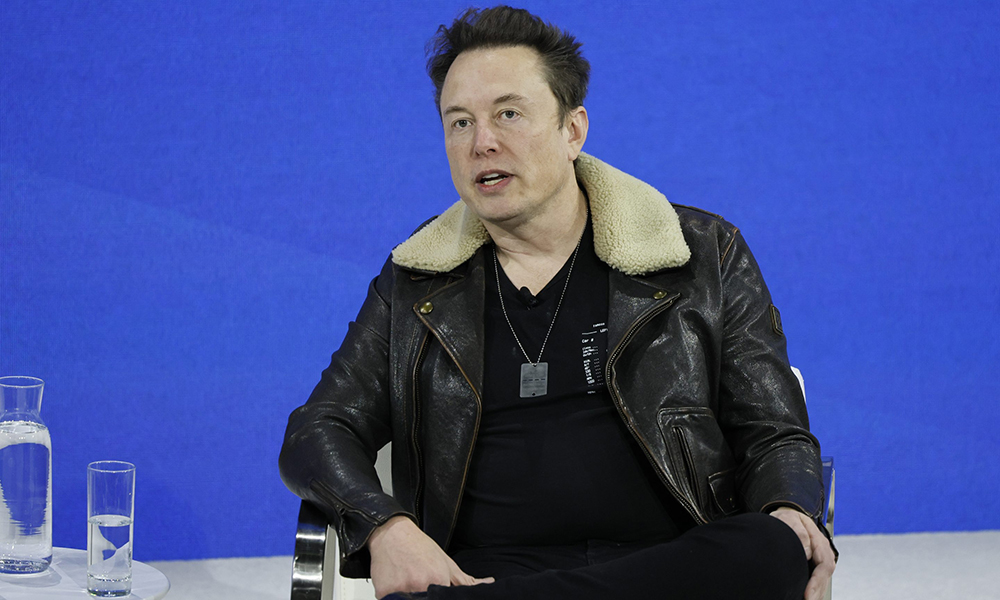
特斯拉(Tesla Inc.)在2023年的表现异常抢眼,其股价在12个月内近乎翻了一番。然而,埃隆·马斯克的这家电动汽车制造公司在2024年伊始却一反常态,股价表现之差创历年同期之最。
特斯拉的市值在2024年的前两周蒸发了940多亿美元。原因并不难理解:这家总部位于美国得克萨斯州奥斯汀的电动汽车制造商遭遇了一系列负面新闻的冲击,包括汽车租赁巨头赫兹全球控股公司(Hertz Global Holdings Inc.)对电动汽车态度的180度转弯、中国产特斯拉价格的再次下调,以及劳动力成本的上涨趋势。
这一切的背后是电动汽车需求增速的放缓,尤其是在美国市场。
Cowen公司的分析师杰弗里·奥斯本在一次采访中表示:“投资者对特斯拉的主要担忧在于增长的停滞不前。”中国特斯拉的降价进一步加剧了这种担忧,有鉴于中国市场激烈的竞争,电动汽车行业似乎开启了“价格战”模式。
特斯拉的市值在今年年初的降幅创下了公司自2010年上市以来的同期之最。按照百分比计算,特斯拉的市值在进入今年1月之后下滑了12%,是自2016年之后表现最差的一年。当时,特斯拉股价在进入1月的前九个交易日下跌了14%。
令其雪上加霜的是,这家电动汽车制造商在短期内扭亏为盈的可能性并不大。
自2023年年初以来,特斯拉一直在通过降价来提振市场需求。受此影响,其丰厚的利润率不断遭到侵蚀。不计监管积分,特斯拉汽车第三季度毛利率从一年前的27.9%降至16.3%。然而,随着其美国工厂工人的涨薪,压力只会有增无减。
Spear Invest的首席投资官伊万娜·德列夫斯卡在接受采访时说:“我们正在经历电动汽车的周期性低迷,但竞争态势加剧了周期性压力,而且这种不利的态势导致了降价和利润率暴跌。”
然而祸不单行,据知情人士透露,出于对西方军事行动和红海安全的担忧,特斯拉在给德国柏林工厂发货时不得不绕道而行,而且在1月29日至2月11日期间将暂停柏林附近工厂的大多数生产任务。
特斯拉投资者经历的当头棒喝
特斯拉在2023年10月发布的第三季度财报里首次警告称,电动汽车需求将有所放缓。此消息一出,全球汽车制造商和供应商亦纷纷发表了悲观预测,很多汽车制造商还取消了其扩张计划。
本月早些时候,特斯拉公布了第四季度交付数据,尽管好于分析师预期,但其全球电动汽车销量仍然落后于中国的比亚迪。
对特斯拉的投资者而言,这一结果无异于当头棒喝。2023年,其股价表现在标准普尔500指数(S&P 500)里名列第八位。然而,公司自年初至今的股价表现则是倒数第八位。
自然,马斯克本人也遭受了很大的冲击。彭博亿万富翁指数(Bloomberg Billionaires Index)称,尽管这位世界首富在2023年赚取的财富可谓是冠绝全球,但其净资产在年初至今的这段时间内缩水了230亿美元。2023年,马斯克超越了贝尔纳·阿尔诺重回该榜单榜首位置。现如今,杰夫·贝佐斯正在快速逼近,在1月12日收盘时达到了1,790亿美元,而马斯克的净资产为2,060亿美元。
马斯克净资产的主体源自于其在特斯拉13%的股份,以及约3.04亿美元的可行权股票期权。彭博的财富指数显示,他还持有太空探索技术公司(SpaceX)约42%的股份,价值约为530亿美元。
尽管如此,特斯拉依旧在全球燃油车电动化转型过程中发挥着关键作用。原因在于它到目前为止仍旧领先于潜在的竞争对手。虽然中国比亚迪的销量已经超过了特斯拉,但收入和利润依然落后。比亚迪并没有进入美国市场,而特斯拉仍然是该市场的霸主。
从很多方面来看,特斯拉最大的问题可能在于过往的成功光环以及由此而来的外界期望。随着投资者的涌入,特斯拉市值迅速膨胀,远超全球任何一家汽车企业。然而,过高的股价让特斯拉极易受到负面消息的影响。
这也是众多支持者认为,特斯拉不应该与传统车企相比较的原因。对他们来说,特斯拉真正的价值在于未来,而且该公司有望开发出第一辆真正意义上的自动驾驶汽车。唯一的问题在于,特斯拉多年来一直停留在口头承诺上,而大多数专家认为该技术还需要几年,甚至几十年的时间才能够实现。
Spear公司的德列夫斯卡说:“特斯拉尚未兑现完全自动驾驶和人工智能的承诺,但这些承诺已经体现在了估值里。要撑起7,500亿美元的估值,光靠生产汽车是不够的。”(财富中文网)
——马特·特纳(Matt Turner)、克里斯汀·欧拉姆(Kristine Owram)和爱德华·勒德洛(Edward Ludlow)对本文亦有贡献。
译者:冯丰
审校:夏林
特斯拉(Tesla Inc.)在2023年的表现异常抢眼,其股价在12个月内近乎翻了一番。然而,埃隆·马斯克的这家电动汽车制造公司在2024年伊始却一反常态,股价表现之差创历年同期之最。
特斯拉的市值在2024年的前两周蒸发了940多亿美元。原因并不难理解:这家总部位于美国得克萨斯州奥斯汀的电动汽车制造商遭遇了一系列负面新闻的冲击,包括汽车租赁巨头赫兹全球控股公司(Hertz Global Holdings Inc.)对电动汽车态度的180度转弯、中国产特斯拉价格的再次下调,以及劳动力成本的上涨趋势。
这一切的背后是电动汽车需求增速的放缓,尤其是在美国市场。
Cowen公司的分析师杰弗里·奥斯本在一次采访中表示:“投资者对特斯拉的主要担忧在于增长的停滞不前。”中国特斯拉的降价进一步加剧了这种担忧,有鉴于中国市场激烈的竞争,电动汽车行业似乎开启了“价格战”模式。
特斯拉的市值在今年年初的降幅创下了公司自2010年上市以来的同期之最。按照百分比计算,特斯拉的市值在进入今年1月之后下滑了12%,是自2016年之后表现最差的一年。当时,特斯拉股价在进入1月的前九个交易日下跌了14%。
令其雪上加霜的是,这家电动汽车制造商在短期内扭亏为盈的可能性并不大。
自2023年年初以来,特斯拉一直在通过降价来提振市场需求。受此影响,其丰厚的利润率不断遭到侵蚀。不计监管积分,特斯拉汽车第三季度毛利率从一年前的27.9%降至16.3%。然而,随着其美国工厂工人的涨薪,压力只会有增无减。
Spear Invest的首席投资官伊万娜·德列夫斯卡在接受采访时说:“我们正在经历电动汽车的周期性低迷,但竞争态势加剧了周期性压力,而且这种不利的态势导致了降价和利润率暴跌。”
然而祸不单行,据知情人士透露,出于对西方军事行动和红海安全的担忧,特斯拉在给德国柏林工厂发货时不得不绕道而行,而且在1月29日至2月11日期间将暂停柏林附近工厂的大多数生产任务。
特斯拉投资者经历的当头棒喝
特斯拉在2023年10月发布的第三季度财报里首次警告称,电动汽车需求将有所放缓。此消息一出,全球汽车制造商和供应商亦纷纷发表了悲观预测,很多汽车制造商还取消了其扩张计划。
本月早些时候,特斯拉公布了第四季度交付数据,尽管好于分析师预期,但其全球电动汽车销量仍然落后于中国的比亚迪。
对特斯拉的投资者而言,这一结果无异于当头棒喝。2023年,其股价表现在标准普尔500指数(S&P 500)里名列第八位。然而,公司自年初至今的股价表现则是倒数第八位。
自然,马斯克本人也遭受了很大的冲击。彭博亿万富翁指数(Bloomberg Billionaires Index)称,尽管这位世界首富在2023年赚取的财富可谓是冠绝全球,但其净资产在年初至今的这段时间内缩水了230亿美元。2023年,马斯克超越了贝尔纳·阿尔诺重回该榜单榜首位置。现如今,杰夫·贝佐斯正在快速逼近,在1月12日收盘时达到了1,790亿美元,而马斯克的净资产为2,060亿美元。
马斯克净资产的主体源自于其在特斯拉13%的股份,以及约3.04亿美元的可行权股票期权。彭博的财富指数显示,他还持有太空探索技术公司(SpaceX)约42%的股份,价值约为530亿美元。
尽管如此,特斯拉依旧在全球燃油车电动化转型过程中发挥着关键作用。原因在于它到目前为止仍旧领先于潜在的竞争对手。虽然中国比亚迪的销量已经超过了特斯拉,但收入和利润依然落后。比亚迪并没有进入美国市场,而特斯拉仍然是该市场的霸主。
从很多方面来看,特斯拉最大的问题可能在于过往的成功光环以及由此而来的外界期望。随着投资者的涌入,特斯拉市值迅速膨胀,远超全球任何一家汽车企业。然而,过高的股价让特斯拉极易受到负面消息的影响。
这也是众多支持者认为,特斯拉不应该与传统车企相比较的原因。对他们来说,特斯拉真正的价值在于未来,而且该公司有望开发出第一辆真正意义上的自动驾驶汽车。唯一的问题在于,特斯拉多年来一直停留在口头承诺上,而大多数专家认为该技术还需要几年,甚至几十年的时间才能够实现。
Spear公司的德列夫斯卡说:“特斯拉尚未兑现完全自动驾驶和人工智能的承诺,但这些承诺已经体现在了估值里。要撑起7,500亿美元的估值,光靠生产汽车是不够的。”(财富中文网)
——马特·特纳(Matt Turner)、克里斯汀·欧拉姆(Kristine Owram)和爱德华·勒德洛(Edward Ludlow)对本文亦有贡献。
译者:冯丰
审校:夏林
Tesla Inc. had a blockbuster 2023, as its shares more than doubled in 12 months. But 2024 is starting on a different note, with Elon Musk’s electric vehicle maker off to its worst start to any year — ever.
The company has lost more than $94 billion in market valuation in just the first two weeks of 2024. It’s not hard to figure out why, as the Austin, Texas-based EV maker has been pounded by a barrage of negative news: an about-face on EVs from the car rental giant Hertz Global Holdings Inc., yet another price cut for its cars made in China, and signs of rising labor costs.
All of this comes in the face of slowing growth in demand for EVs, especially in the US.
“Investors’ main concern on Tesla is stagnating growth,” Cowen analyst Jeffrey Osborne said in an interview. The price cuts in China only fan those concerns, because it is starting to look like “a race to the bottom for the EV industry given intense competition in that market.”
The hit to Tesla’s market capitalization to start the year is the biggest the company has seen over a similar period since it went public in 2010. In percentage terms, Tesla’s 12% drop since the start of January is the worst since 2016, when the stock fell 14% over the first nine trading days of the year.
To make matters worse, the odds of an imminent turnaround for the EV maker don’t look good.
Tesla has been cutting prices on its cars aggressively since early 2023 in an effort to boost demand. But the result has been a steady erosion of its once-hefty profit margin. Tesla’s automotive gross margin ex-regulatory credits for the third quarter fell to 16.3% from 27.9% a year ago. And the pressure is only mounting, now that production workers at Tesla’s US plants are getting pay raises.
“We are going through a cyclical downturn for EVs, but competitive dynamics are exacerbating the cyclical pressures,” Ivana Delevska, chief investment officer at Spear Invest, said in an interview. “Price cuts and plummeting margins are all a function of these unfavorable competitive dynamics.”
Adding to the woes, Tesla has had to re-route shipments destined for its Berlin plant after Western military actions and security concerns in the Red Sea, and is suspending most production at its plant near Berlin from Jan. 29 to Feb. 11, according to a person familiar with the matter.
Rude awakening for Tesla investors
Tesla first warned about the deceleration in EV demand during its October third-quarter earnings report. Almost immediately after, automakers and suppliers across the globe chimed in with their own downbeat forecasts. Many carmakers dialed back their plans for expansion.
Then, earlier this month, Tesla reported its fourth-quarter delivery numbers. While they were better than what analysts expected, they put the company behind China’s BYD Co. in global electric-car sales.
The result has been a rude awakening for Tesla investors. Last year, the stock was the eighth best performer in the S&P 500. So far this year, it’s the eighth worst.
Naturally, Musk is taking a big hit personally. The world’s richest person, who gained more wealth in 2023 than anyone else on the planet, has seen his net worth shrink by $23 billion so far this year, according to the Bloomberg Billionaires Index. Musk regained the top spot on Bloomberg’s wealth index last year, overtaking Bernard Arnault, but now Jeff Bezos is rapidly closing in, with $179 billion to Musk’s $206 billion as of January 12’s close.
The bulk of Musk’s net worth comes from his 13% stake in Tesla and about 304 million exercisable stock options. He also owns about 42% of SpaceX, which is valued at about $53 billion, according to Bloomberg’s wealth index.
With all that being said, Tesla remains a key player in the global transition from gas-powered vehicles to largely electric ones. The reason: It’s so far ahead of its potential rivals. China’s BYD may have surpassed Tesla in the number of units sold, but it still lags in revenue and profits. And BYD doesn’t sell cars in the US, where Tesla remains the market leader.
In many ways, Tesla’s biggest problem may be its past success and the hope it generated. As investors piled into the stock, Tesla’s market capitalization ballooned, making it way larger than any other car company in the world. However, with the shares priced for perfection, that also made them highly vulnerable to big reactions to any negative news.
That’s why so many Tesla proponents argue that it shouldn’t be compared to regular car companies. To them, the ultimate true value of the company rests in the future and it’s hope to develop the first truly self-driving vehicles. The only problem is Tesla has been promising this for years, and most experts say the technology is still years, maybe even decades, away.
“Tesla has not been able to deliver on fully autonomous driving and AI promises, which are already embedded in the valuation,” Spear’s Delevska said. “Being simply another automotive manufacturer is not going to cut it for a $750 billion valuation.”
— With assistance from Matt Turner, Kristine Owram, and Edward Ludlow






